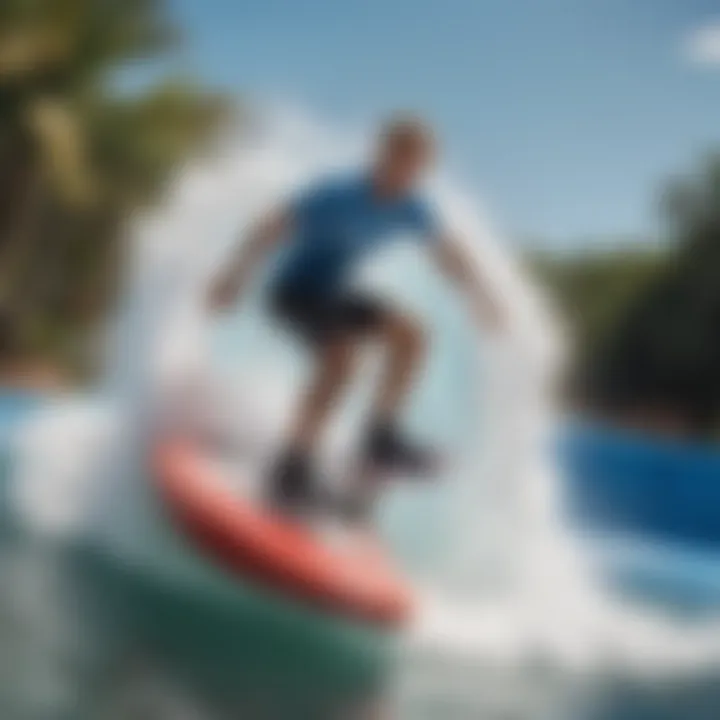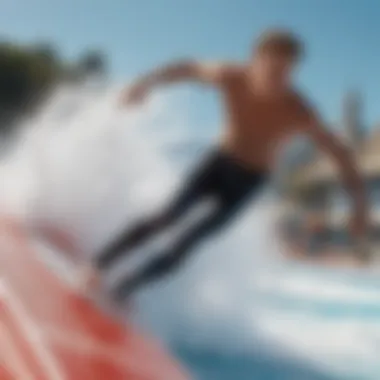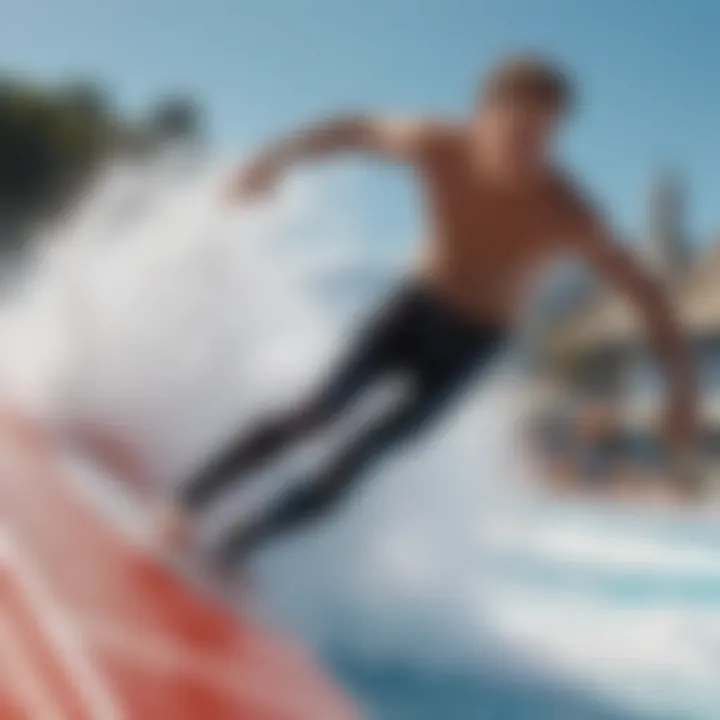Exploring Flowrider Surfing: Mechanics and Culture


Intro
Flowrider surfing has captured the imagination of thrill-seekers and surfing enthusiasts alike. This innovative sport brings together aspects of traditional surfing and wakeboarding, creating new experiences for participants. By harnessing the art of riding waves generated by an artificial surf machine, Flowrider provides a unique opportunity for individuals to engage in surfing regardless of ocean conditions. Understanding the science behind the Flowrider system lays the foundation for appreciating this sport's appeal and its cultural significance within the broader spectrum of extreme sports.
Extreme Sports Overview
Definition of Extreme Sports
Extreme sports are activities that involve a high degree of risk. These sports often require participants to have specialized skills and sometimes include elements of speed, height, or a combination of both. Flowrider surfing fits into this category as it challenges riders to maintain balance and control while navigating dynamic water flows.
History and Evolution
The concept of Flowrider emerged in the late 1990s, developed by a team of engineers and surfers looking to create an artificial wave system. Over the years, this technology has evolved, allowing for smoother rides and greater customization. Surf parks equipped with Flowrider machines have sprung up across the globe, making this sport more accessible.
Popular Extreme Sports Disciplines
Extreme sports encompass various disciplines, each with its unique characteristics. Some popular types aside from Flowrider surfing include:
- Skateboarding: Riding and performing tricks on a skateboard.
- Bungee Jumping: Leaping from a great height while connected to a large elastic cord.
- Snowboarding: Descending snow-covered slopes on a snowboard.
- Parkour: Navigating urban environments with speed and agility.
Gear and Equipment
Essential Gear for Different Sports
For effective Flowrider surfing, specific gear is essential. Unlike traditional surfing, where larger surfboards are used, Flowrider requires a shorter, more maneuverable board. Typical gear includes:
- Rash Guard: Prevents chafing and provides sun protection.
- Boardshorts or Swimwear: Comfortable clothing that allows for a full range of motion.
Gear Reviews and Comparisons
It's crucial to choose quality gear that suits personal preferences and body types. Some notable brands may include:
- O'Brien: Known for durable and performance-focused boards.
- Liquid Force: Offers a range of boards and apparel.
Safety Ratings and Certifications
Safety is paramount in extreme sports. Ensuring that equipment meets industry safety standards is essential. Look out for certifications from recognized organizations that test gear for durability and safety.
Training and Preparation
Physical Conditioning and Fitness Tips
To excel in Flowrider surfing, participants must maintain core strength and balance. Regular workouts focusing on the core, legs, and overall flexibility can enhance performance. Activities like yoga and pilates can also aid in developing body awareness and control.
Mental Preparation Techniques
Mental toughness plays a significant role in extreme sports. Visualization techniques can help riders to anticipate the flow of water and improve reaction times. Setting realistic goals and progressively pushing limits helps build confidence.
Training Regimens for Various Sports
While Flowrider surfing shares similarities with wakeboarding, each sport has specific training techniques. Regular practice on Flowrider machines allows individuals to refine their skills, understand the water dynamics, and develop muscle memory.
Locations and Destinations
Top Destinations for Extreme Sports
Globally, several locations are recognized for their impressive extreme sports facilities, including:
- Wavehouse in San Diego, California: Offers an outdoor Flowrider experience.
- Surf Snowdonia in Wales: Features an advanced surfing lagoon.
Travel Tips and Guides


Traveling to experience the best Flowrider surfing can be exciting. It's essential to plan ahead, including booking sessions at popular sites and checking for availability. Additionally, understanding local weather conditions can be helpful for maximizing the experience.
Flowrider surfing not only provides a thrilling ride but also builds community among water sports enthusiasts, fostering a culture of shared passion and excitement.
Prolusion to Flowrider Surfing
Flowrider surfing represents a unique convergence of traditional surfing elements and advanced engineering, offering enthusiasts a thrilling and safe way to experience the ocean's excitement. As water sports gain popularity, understanding Flowrider surfing is essential for both newcomers and seasoned athletes alike. This section aims to elucidate key aspects related to Flowrider, emphasizing its significance in the broader landscape of extreme sports.
The importance of Flowrider surfing can be viewed through its wide-ranging benefits, such as a controlled environment that is inherently safer than traditional surfing. Participants can enjoy the sensation of riding waves without the unpredictability associated with ocean surfing. Flowriders also provide year-round accessibility, allowing surfers to practice their skills regardless of location or season.
Definition and Concept
Flowrider surfing can be defined as an indoor surfing experience that utilizes a stationary sheet of water to replicate wave-like conditions. The water flows over a sloped surface, creating a standing wave effect which riders can surf upon. This setup allows surfers to perform multiple tricks and maneuvers without needing to paddle back to the crest of a wave.
The concept behind Flowrider technology integrates elements from wakeboarding and regular surfing. It aims to make the experience approachable, combining the thrill of surfing with a level of safety that reduces the risks often associated with ocean waves. Flowrider parks typically feature trained staff to guide and assist users, showcasing the blend of technology and user experience.
Brief History of Flowrider Technology
The inception of Flowrider technology dates back to the late 1990s when innovative thinkers sought to bring the surfing experience to a stationary context. The first prototype was developed by a company called Wave House in San Diego. As demand for alternative surfing experiences grew, Flowrider technology was refined, enhancing wave quality and rider experience.
Over the years, Flowrider has seen global expansion, making its way into various water parks and leisure facilities. Different systems of Flowriders emerged, each boasting unique features, but all fundamentally focused on delivering an immersive and enjoyable experience for surfers of all skill levels.
The journey of Flowrider technology encapsulates not only the evolution of a sport but also the emergence of a new community centered around innovative water-based activities.
Understanding the Mechanics Behind Flowriders
Flowrider technology is complex yet fascinating, and understanding its mechanics provides insight into what makes indoor surfing a unique experience. It bridges traditional surfing and wakeboarding, catering to all skill levels. When engaging with Flowrider, both enthusiasts and novices benefit from grasping the principles that govern operation and performance. This comprehension can enhance the surfing experience significantly, making it more enjoyable and safe.
How the Flowrider Works
The Flowrider comprises a flat, inclined surface with a sheet of water flowing over it. This setup creates a continuous wave-like effect, allowing surfers to ride indefinitely in one spot. Water is pumped at controlled speeds, and surfers use balance along the board to stay atop the surface. By adjusting the water flow and angle of inclination, the intensity and difficulty of the ride can be modified. For beginners, lower speeds are recommended, while advanced surfers can increase the flow for an added challenge.
Surfers take turns on the Flowrider, which allows for a social environment. The capacity for multiple riders means more opportunities for practice and fun. Importantly, there is a learning curve with Flowrider surfing. Surfers must develop their balance and core strength for better performance.
Water Dynamics and Wave Creation
Water dynamics play an essential role in how the Flowrider operates. The speed and direction of water flow are critical to wave formation. When water is pushed down the slope, it generates a thin layer that behaves like a wave, allowing a surfer to ride along its surface. This constant movement creates a unique experience where the surfer can carve, practice tricks and develop skills, similar to that of ocean surfing but in a controlled environment.
Factors such as water speed, board shape, and surfer's posture impact wave stability. Through experiments with these variables, surfers can learn to optimize their performance. Mastery of these principles can lead to quicker progression, ensuring the surfing experience is both fulfilling and engaging.
Type of Flowrider Systems Available
There are various types of Flowrider systems tailored to different spaces and user experiences. Some popular systems include:
- FlowRider Double: This system allows two surfers to ride side by side, promoting interaction and competition.
- FlowRider Single: Designed for individual use, it offers focused training and practice sessions.
- FlowRider Xtreme: An advanced version catering mainly to seasoned surfers, it typically features higher water flow and incline.
Each system boasts its unique perks, meeting the needs of various facilities, from theme parks to gyms. Understanding these distinctions helps enthusiasts choose the right setup to suit their preferences.
"The seamless blend of technology and sport makes Flowrider surfing a compelling activity for both beginners and experienced riders."
This fundamental knowledge equips surfers to make the most of their Flowrider experiences. Knowing how the systems work can help identify the right environment for practice, enabling tailored skill development.
Benefits of Indoor Flowrider Surfing
Indoor Flowrider surfing presents distinct advantages that make it a compelling choice for water sports enthusiasts. The controlled environment, consistent water conditions, and safety protocols contribute to a unique surfing experience. Understanding these benefits can enhance your appreciation and enjoyment of this sport.
Safety and Controlled Environment
One of the primary benefits of Flowrider surfing is the safety provided by its controlled environment. Unlike traditional surfing, where changing tides, unpredictable waves, and natural hazards can pose risks, Flowriders operate on a stable, man-made surface. This environment minimizes the chance of injury due to unforeseen circumstances. Surfers can focus on technique and enjoyment without the worry of falling onto rocky shores or dealing with marine life.
Furthermore, Flowrider facilities often implement specific safety measures, such as the use of padded surfaces and safety equipment. These protocols ensure that even new surfers can engage with the sport safely.
Year-Round Accessibility


Another significant advantage is the year-round accessibility of Flowrider surfing. Many Flowrider setups are housed in indoor facilities, making them immune to weather conditions. This is particularly beneficial for regions with harsh winters or seasonal variations that limit outdoor surfing. Enthusiasts can practice their skills regardless of the climate or time of year. This accessibility encourages aspiring surfers to maintain their practice and develop their abilities consistently, fostering a continuous improvement mindset.
Skill Development and Progression
Flowrider surfing also provides an excellent platform for skill development and progression. Due to the nature of the Flowrider, surfers can practice various techniques repeatedly without traveling long distances to find suitable waves. Beginners can hone basic stances and techniques in a forgiving environment while advanced surfers can work on tricks and maneuvers.
The emphasis on progression helps build a strong foundation of skills, setting the stage for success in both Flowrider surfing and traditional surfing disciplines.
"Flowrider surfing provides a safe and controlled space to refine skills, making it an ideal choice for both beginners and experts."
The benefits of indoor Flowrider surfing encompass safety, accessibility, and skill development. These factors ultimately enrich the surfing experience, offering a valuable alternative to traditional water sports.
Techniques for Mastering Flowrider Surfing
Mastering Flowrider surfing is crucial for those looking to enjoy the sport to its fullest. Understanding and refining techniques can significantly enhance the overall experience, making it more enjoyable and safer. This section will provide insights on the importance of mastering these techniques. The benefits are not limited to increased proficiency but also include a deeper appreciation for the nuances of flowriding. Knowledge of specific techniques can lead to a reduced risk of injury and heightened confidence while surfing.
Basic Stances and Positions
In Flowrider surfing, the correct stance provides the foundation for all movements. Whether a novice or experienced rider, it is essential to understand the basic positions. The most common stances are the drop knee, standing upright, and the kneeling position.
- Drop Knee: This position involves one knee on the surfboard while the other foot is planted, providing balance and stability. It is essential for beginners as it allows for better control of the board.
- Standing Upright: This stance offers a full view of the wave and is used as surfers become more comfortable. Maintaining the center of gravity is crucial to prevent falls.
- Kneeling Position: For those who prefer control while trying tricks, kneeling can be a safer way to ride. This position is often favored during trick attempts.
Finding the right stance requires practice. A balance between comfort and control leads to confidence on the board. This allows surfers to progress to more advanced techniques and tricks.
Common Moves and Tricks
Once the basic stances are mastered, surfers can begin to learn common moves and tricks. Some of these include:
- 360 Spins: Executed by twisting the body and board in one fluid motion, this trick adds flair but requires practice and balance.
- Ollies: A technique where the rider pops the board into the air, often used to clear obstacles or start spins.
- Grabs: Involves grabbing the board mid-air, showcasing style and control.
- Carving: A foundational maneuver that allows surfers to change direction with fluidity, creating a flow with the wave.
Each trick requires dedication and can be improved incrementally. It is recommended to begin with simple moves before progressing to more complex ones to ensure skill development and safety.
Tips for Beginners and Advanced Surfers
As with any sport, different types of surfers have different needs. Here are some tailored tips for both beginners and advanced surfers:
For Beginners:
- Start slow and focus on controlling your body position.
- Spend time observing others to see techniques in action.
- Practice basic stances on dry land before hitting the Flowrider.
For Advanced Surfers:
- Work on higher difficulty tricks during off-peak hours for more practice time.
- Utilize video footage to analyze your technique and identify areas for improvement.
- Seek feedback from instructors for personalized tips.
Understanding these aspects of Flowrider surfing helps individuals refine their skills. As one combines the stances, moves, and tips tailored to their level, the overall enjoyment and proficiency in the sport increase.
"Success in Flowrider surfing comes from patience and practice. Improvement is a journey that rewards determination."
By honing these techniques, surfers can navigate the challenges that Flowriders present and enjoy a more fulfilling experience.
Safety Protocols in Flowrider Surfing
Safety protocols are crucial in Flowrider surfing. As an extreme sport, it comes with inherent risks. Understanding and implementing safety measures can significantly reduce the likelihood of injury. The purpose of these protocols is not only to protect individuals but also to promote an enjoyable and feasible surfing experience. This segment will outline several key components of safety in Flowrider surfing.
Essential Safety Equipment
Proper safety equipment is fundamental to ensuring a secure environment for Flowrider participants. Here are some critical items:
- Wetsuit: Provides thermal protection and cushioning. It can lessen the impact during falls.
- Helmet: Protects the head from injuries. It is essential to use a well-fitting helmet designed for water sports.
- Impact Vest: This offers additional buoyancy and impact protection during surfing sessions.
- Leash: Attaching a leash to the board helps in retrieving the board post-fall and prevents it from becoming a hazard.
- Buoyancy Aids: These can be beneficial for beginners or those who are less confident in the water.
Using the appropriate equipment enhances safety and helps in learning efficient movement on the Flowrider.


Instructors and Supervision
Instructors play an essential role in ensuring safe experiences for Flowrider participants. They should be experienced in water sports and trained in safety protocols. Here are several aspects related to instructors and supervision:
- Training: Instructors need to be certified in water safety, lifeguarding, and Flowrider-specific techniques.
- Pre-session Briefing: They must provide a detailed briefing to participants regarding safety procedures, necessary equipment, and potential risks before allowing them to surf.
- Monitoring: Constant supervision during surf sessions is vital. Instructors must be alert and ready to intervene at any point to avoid accidents.
- Clear Signals: Establishing non-verbal cues helps participants communicate effectively with instructors while surfing.
Emergency Procedures and First Aid
Despite planning for safety, unexpected incidents can happen. Thus, having clear emergency procedures is important. This includes:
- Emergency Plans: Facilities must have a defined escape plan in case of emergencies. Staff should know evacuation routes and where to find safety equipment, if necessary.
- First Aid Kits: These kits should be accessible at every Flowrider facility and should contain appropriate supplies such as bandages, antiseptics, and other essential items.
- Training in First Aid: Staff must be trained to administer first aid in case of minor injuries or incidents. This includes knowing how to respond to incidents like falls, cuts, or minor concussions.
- Communication: Ensure that participants are aware of how to get help in case of an emergency, including using whistles, bells, or headsets.
Remember: Safety protocols are key to minimizing risks and ensuring an enjoyable experience in Flowrider surfing. Knowing how to respond properly can make a critical difference.
Cultural Impact of Flowrider Surfing
The cultural significance of Flowrider surfing extends beyond its allure as a novel water sport. This innovative activity mirrors the evolution of extreme sports, bringing traditional surfing and wakeboarding into a controlled indoor setting. It represents a shift in recreational activities, emphasizing inclusivity and accessibility, while also fostering a unique community.
One major aspect of Flowrider's cultural impact lies in its integration into leisure facilities worldwide. It allows individuals of different skill levels to experience the thrill of surfing without the constraints of weather or geography. This democratization of the surf experience broadens participation, attracting not only seasoned athletes but also beginners eager to try something new. The social environment encourages camaraderie and shared experiences, which significantly contribute to its cultural relevance.
Flowrider in Popular Culture
Flowrider surfing has found its place in popular culture, becoming a recognized symbol of active living and adventure. This sport is featured in various media outlets, from lifestyle magazines to television shows that focus on extreme sports. The combination of surfing and the novelty of artificial waves captures interest, showcasing the athletic prowess required to master the Flowrider.
The rise of social media platforms also amplifies its cultural presence. Enthusiasts often share videos and photos of their Flowrider experiences, creating a vibrant online community. Brands associated with extreme sports further leverage this popularity to promote their products, often collaborating with influencers. The Flowrider also appears at events and competitions, reflecting its growing stature within the extreme sports community.
Global Growth of Flowrider Facilities
The proliferation of Flowrider facilities marks a significant trend in the recreation industry. These venues are popping up in water parks, resorts, and fitness centers globally. The investment in such facilities underscores the demand from thrill-seekers and recreational enthusiasts alike. Many of these locations offer professional instruction and a structured environment, attracting novices and experienced surfers in equal measure.
As Flowrider facilities expand, they create sustainable growth for local economies. Many resorts and cities use these attractions as a way to draw tourists, thus creating jobs and stimulating community engagement.
The global growth trend points to a future where Flowrider surfing may become as mainstream as traditional extreme sports. Its ability to provide a safe and fun surfing experience translates into a flourishing community that values skill, adventure, and inclusivity.
The Future of Flowrider Surfing
The future of Flowrider surfing holds significant potential, expanding not only the technologies but also the communities surrounding this popular water sport. As the sport gains momentum, understanding its trajectory is crucial. Emphasizing innovation and community growth will enhance the relevance of Flowrider surfing for both seasoned enthusiasts and newcomers.
Innovations and Technological Developments
Recent advancements in technology are revolutionizing Flowrider surfing. Companies continually develop more efficient water flow systems, providing smoother rides and more realistic wave patterns. These improvements cater to a variety of skill levels, making the sport more accessible to beginners while still challenging for advanced surfers. New materials are being used for surfboards, which allow for better performance, stability, and durability.
Furthermore, integration of digital technology is on the rise. Some Flowrider facilities are experimenting with augmented reality, helping users track their progress on skill and technique. This not only engages users but also allows them to set personal goals and monitor their improvement.
Innovations also focus on energy efficiency. Several facilities are exploring sustainable energy sources to power Flowrider systems. This is a significant step towards making Flowrider surfing more environmentally friendly and appealing to those who prioritize sustainability.
Expanding the Flowrider Community
The Flowrider community is continually growing, fueled by increased interest in extreme sports. Various programs and events are emerging to promote inclusivity and accessibility. Competitions are being organized at local, national, and international levels. These competitions not only highlight talent but also foster a sense of camaraderie among surfers.
Collaboration with schools and youth organizations is another strategy to expand community engagement. Many indoor surfing facilities partner with educational institutions to provide students with surfing experiences. This early exposure cultivates a new generation of surfers who appreciate the sport's nuances.
Social media platforms, like Reddit and Facebook, also play a crucial role in fostering community. Surfers often share tips, tricks, and personal experiences, building a network of enthusiasts. This digital presence has made sharing knowledge and experiences easier, which can encourage more people to try Flowrider surfing.
"As Flowrider technology continues to evolve, so too will the potential it offers for performance, engagement, and community outreach."
Ending
The way we think about Flowrider surfing is crucial to understanding its role in modern extreme sports. This article discusses various elements that shape the world of Flowrider surfing, including its unique mechanics and diverse benefits for participants. Not only does this sport offer an alternative to traditional surfing, but it also provides a safer environment for skill exploration.
One significant aspect to consider is the blend of exhilaration and safety that Flowrider brings. Enthusiasts can enjoy endless waves while being surrounded by protective measures, such as instructors and safety gear. This is a major benefit because it allows for risk-taking without as many of the dangers found in open water surfing.
Moreover, accessibility year-round is a notable consideration. Facilities often operate in indoor environments, eliminating seasonality challenges while promoting skill development throughout the year. The global growth of Flowrider installations indicates a demand for this sport, reflecting its increasing relevance in the leisure and fitness landscapes.
In summary, understanding this art of surfing expands one's appreciation for the sport. Recognizing its mechanics, the safety considerations involved, and the cultural implications helps enthusiasts and newcomers alike navigate the Flowrider experience more effectively. Awareness of these factors enriches one’s engagement with the Flowrider community and encourages a deeper connection to this unique water sport.
Recap and Final Thoughts
Ultimately, Flowrider surfing is not just about riding waves; it is about the experience of being part of a dynamic and expanding community that celebrates both adrenaline and artistry in equal measure.







